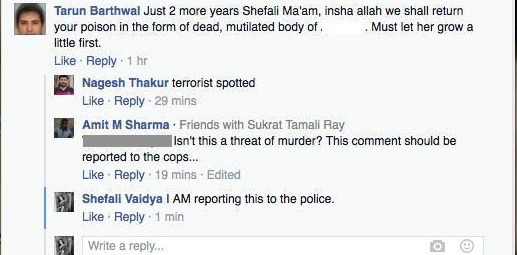This is a follow up of a prior post on the issue of online intimidation by journalists, of ordinary social media users, especially of serving armed forces officers. I was witness to a similar incident, where a pair of journalists ganged up on someone, apparently a serving officer.
It started when the officer objected to one of them linking recent statements of Gen VK Singh as a minister, to question his selection for the army by the SSB. The journalist, instead of arguing the point raised, started mocking the questioner, and soon his colleague joined in taunting the officer. He even insinuated that the officer was being paid a ‘twitter allowance’ for his tweets.

Undeterred, the officer persisted with his original query.

The journalist’s reply was a shocker – that just because the general had served in the army, he had no right to be in politics.
He then switched to personal attacks, even questioning the officer’s courage in battle. He continued mocking the officer, asking him if he had ‘filled up his forms to be on social media’, and then even accused him of being an impostor.


A few veterans including myself noticed this conversation and questioned the journalist’s assertions. Again, instead of debating his stand/views, he insinuated that I was being paid ‘twitter allowance’, and then proceeded to block me.


The whole episode raises serious questions about the conduct of such journalists vis à vis serving officers. The environment on social media has resulted in every assertion and utterance of anybody being open to scrutiny and remark. It’s an undeniable fact that after politicians, journalists are probably the most ‘trolled’ group online. There is a large section of people who are openly abusive and insulting to them, and this must be quite trying on their patience. There is very little they can do to such abusers apart from ignoring/blocking them. However, there is a distinct trend amongst the defence journalists to turn around and browbeat service officers, even when they’re not abusive and ask perfectly reasonable questions. This and this previous post on a similar exchange are clear illustrations of this trend.
The question is, why do these journalists, otherwise helpless against even the most abusive of trolls, consider service officers soft targets for venting their pent-up frustrations? By virtue of their beat, these defence correspondents get frequent opportunities to interact with senior officers. While visiting units and formations to cover stories, they are treated with the utmost respect and courtesy, with junior officers even being deferential to them (as they are with all guests). This possibly creates in their own mind a false sense of their own position being relatively higher up in the military hierarchy. Thus the obvious sense of outrage and contempt when their views are questioned online by a relatively junior officer.
Being familiar with the military environment, they are aware that if they report an alleged transgression by an officer to the highest headquarters (accessible to them due to their professional role), the officer concerned is likely to get in some amount of trouble. Although there are no rules prohibiting officers from being on social media and expressing their views (except on service and other prescribed matters), to a young officer serving a unit, a complaint of alleged misconduct coming down the chain of command all the way from Army HQ via intermediate formations would mean a lot of harassment, irrespective of the veracity of the charges. It is this fear that is being exploited by these journalists.
It is nobody’s case that service officers, or anyone for that matter, should be allowed to get away with being abusive or threatening online. Yet, it is also not in order to suppress their rightful freedom of expression just because they are part of a disciplined organization and respect rules. It is a pity if the adherence to the same rules is being used to threaten and browbeat them into silence, even if the issue raised by them are perfectly reasonable and nothing to do with security or service matters.
It is for the organization to take cognizance of such insults being heaped upon its officers and take steps to prevent their recurrence. This can include amplifying the current orders to mention, in addition to what serving personnel can’t do online, what they are permitted to do. We can take a page from similar orders for the US forces which are more elaborate, as under.

In addition, the organization should also look at discouraging such conduct by journalists who derive their sense of power from their accreditation to the organization itself by blacklisting defaulters. And while the importance of good relations with the media is understood, the organization should realize that any wilful disrespect to one of its own members is a disrespect to the organization, and take strong steps to prevent sundry people from walking all over their officers.





















